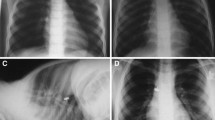Abstract
Purpose.
The purpose of this study was to determine the role of plain chest radiography in the evaluation of patients with suspected foreign–body aspiration.
Materials and methods.
During a 5–year period, 31 patients (18 men and 13 women; age range 6 months to 85 years) were referred to our observation for clinical suspicion of foreign–body aspiration. Clinically, the patients presented with cough in 27/31 cases (87.1%), decreased breath sounds in 22/31 (71%), choking in 18/31 (58.1%), fever in 7/31 (22.6%) and cyanosis in 5/31 (16.1%). Suspected foreign–body aspiration had occurred 2–72 h before hospitalisation. Within 2 h of hospitalisation, all patients underwent plain chest radiography performed in the upright position (two projections) in 10/31 (32.3%) patients and in the supine decubitus position in the remaining 21 (67.7%) patients. Plain chest radiography was subsequently integrated with multislice computed tomography (MSCT) of the chest in 3/31 (9.7%) patients and with bronchoscopy in 27/31 (87.1%) patients.
Results.
Plain chest radiography showed the presence of a foreign body in the tracheobronchial tree in 7/31 (22.6%) patients, who subsequently underwent successful bronchoscopy in all cases. Foreign bodies included tooth fragment (three cases), nail (two cases), metallic spiral of a ball–point pen (one case) and an earring (one case). In the remaining 24/31 patients, plain chest radiography was positive in 14 cases, showing atelectasis (seven cases), pneumonia (six cases), pulmonary hyperinflation (one case) and pneumomediastinum (one case). Such findings had been caused by an aspirated foreign body, which was subsequently removed by means of bronchoscopy in all 14 patients. Moreover, three of the remaining ten patients with negative plain chest radiograph were submitted to MSCT of the chest, which required in 1 case tracheobronchial aspiration of a foreign body that was subsequently removed by means of bronchoscopy. Overall, plain chest radiography showed the presence of foreign–body aspiration and/or pleuroparenchymal lesions in 21/31 patients (67.7%); bronchoscopy was positive in 23/27 patients (85.2%), localising the foreign body in the right main bronchus in 16/27 patients (59.3%), left main bronchus in 7/27 patients (25.9%), intermediate bronchus in 2/27 patients (7.4%) and right lower lobe bronchus in 2/27 patients (7.4%). No late complications were observed within 6 months of hospital discharge.
Conclusions.
Plain chest radiography remains the initial imaging modality for patients with clinically suspected tracheobronchial aspiration of a foreign body. Nevertheless, in the case of negative chest radiography and a clinical suspicion of foreign–body aspiration, MSCT—possibly integrated with virtual bronchoscopy—should be considered in order to avoid unnecessary bronchoscopy.
Similar content being viewed by others
Author information
Authors and Affiliations
Corresponding author
Rights and permissions
About this article
Cite this article
Pinto, A., Scaglione, M., Pinto, F. et al. Tracheobronchial aspiration of foreign bodies: current indications for emergency plain chest radiography. Radiol med 111, 497–506 (2006). https://doi.org/10.1007/s11547-006-0045-0
Received:
Accepted:
Published:
Issue Date:
DOI: https://doi.org/10.1007/s11547-006-0045-0




